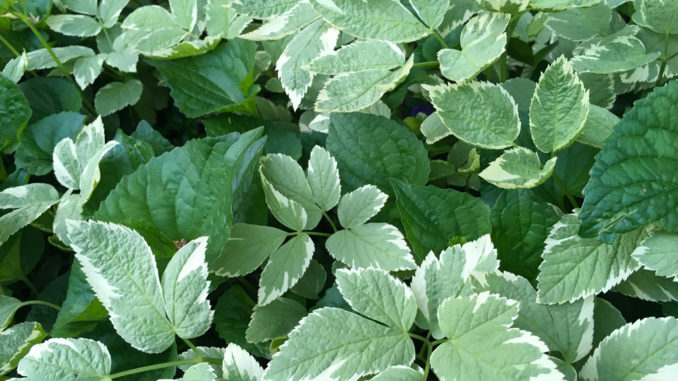
Ecological freeloaders, botanical bullies or terrestrial tyrants are just a few ways to describe the behaviour of invasive plants. They steal resources, smother or strangle other plants and can take over an entire landscape.
The Canadian golden rod is an invasive plant in England and English ivy is now an invasive plant in Canada. These are two examples of how relocating a perfectly good plant from one area to the wrong place can have a negative impact. Humans have been doing this for centuries and we now have invasive plant problems all over the world causing extensive damage at a huge cost both economically and environmentally.
It’s not just temperature and rainfall patterns that allow a plant to adjust to a new environment. Some plants are deeply connected to their community of plants where they support each other and along with local insects and wildlife, they all keep their natural habitat in check. When we relocate such a plant, we rob it of its natural supports and order. This can cause a plant to become aggressive and perhaps it’s only searching for its own community.
Today, the sugar maples and oaks in our ravines are losing ground to Norway maples (specifically chosen by city planners as our street tree) along with dog-strangling vine, Japanese knotweed and garlic mustard (ornamental introductions by our early settlers) smothering the native wild flowers on the forest floor. Though the situation is dire, some believe there is still time to save our ravines, but it will take work and money.
Since the Ford government announced that the Ontario Invasive Plant Council’s funding from the government had been cut, once again we must rely on private organizations, philanthropic donations and volunteers to do what we can.
On June 13, the Leaside Garden Society will present Gabby Nichols from the Ontario Invasive Plant council as guest speaker to provide important information about invasive plants in Ontario and review the popular (my personal favourite) Grow Me Instead plant guide.
I will definitely be there and I hope you will too because now, more than ever, we all need to be informed on how to deal with invasive plants. If you cannot attend, here are some things you need to do:
-Pick up a Grow Me Instead guide or download it online to learn how to identify the invasive plants threatening Ontario.
-Buy native or non-native plants that are compatible from a reputable garden supplier.
-DO NOT buy invasive plants, and if you see them at a garden centre, tell the centre you disapprove.
-Dispose of invasive plants in the garbage. DO NOT compost or discard them in natural areas.
-If you see an invasive plant in a park or any natural area, report it to the Invading Species Hotline at 1-800-563-7711.
-Learn as much as you can, keep up to date and share what you know with others.
-Our individual gardens affect the urban forest of Leaside, our urban forest affects our ravines, woodlands and wetlands, they in turn effect the entire city and on and on it grows. Get it?
Garden Invaders
Two years ago, I wrote “Invasive plants: the road to hell was paved with good intentions” and informed Leasiders that English ivy, periwinkle and lily of the valley were considered invasive plants in Ontario. I also admitted that I had all three in my garden and vowed to take action. At the same time, goutweed snuck in too!
English ivy
Being somewhat evergreen is perhaps the only good quality of English ivy in a Leaside garden. It mostly smothers, strangles and adds extra weight to trees. It also shelters mice and rats. Yikes! Stick with Virginia creeper.
When this one arrived from my north neighbour’s yard, it was only on my fence but quickly started creeping on the ground. It didn’t get to any of my trees so my job was to to snip and pull it off my fence. If it gets on your trees, cut it at the root source (if you can) and let the vine dry and die before you pull it off. On the ground, I simply pulled and dug out as many vines and roots as I could find then added a fresh topping of mulch. Unfortunately, I can’t get to the main root sources, so the best I can do right now, is to keep a watchful eye and remove it when I see it. Bag and seal every bit of leaf and vine for the garbage. Do not compost and do not include with city garden waste!
Lily of the valley

I’m still not sure where my lily of the valley came from but I when it appeared, I thought I was blessed and started potting it up to enjoy the fragrance on my deck. Now I do that even more to exhaust my supply. My way is definitely the slowest but I have removed one large section already and enjoy lovely and fragrant container plants that last for years.
I simply dig out the pips when they’re about 4” tall in the spring but I’ve even done it much later in the season – you can even try it now. Don’t overcrowd them though because they will do that on their own. After three or four years in the same container, they will completely strangle and starve themselves to death. At this stage it’s easy to bag and seal for garbage as one big tangled root mass. Do not compost and do not include with city garden waste!
Periwinkle
This plant came in from my west neighbour’s yard and doesn’t seem to take a hold in my garden. It’s weak and rarely flowers so I just yank it out by its shallow roots whenever I spot it, then add a thick layer of mulch on the root zone. Bag and seal every bit as garbage. Do not compost and do not include with city garden waste!
Goutweed
Again, this one came in from my west neighbour’s yard and has been the hardest one for me to deal with. I tried a few different methods (plastic and newspaper) but found yard waste paper bags to be the most successful so far.
Before it went to flower, I cut off all the leaves until there was nothing but 1”green skinny stems showing. Bag and seal every single leaf and piece as garbage. Do not compost and do not include with city garden waste!
I cut up paper garden waste bags to fit the area and covered it like wall to wall carpeting. I covered that with a thick layer of mulch then decorated it all with a garden statue, a few container plants and some strategically placed rocks. It looked better than a big patch of mulch but mostly, it was the best way to keep the paper and mulch in place. Bad raccoons!
So far, things are looking positive but I did find a few new sprouts this spring. I quickly clipped off the leaves (which I put in a plastic bag for garbage) covered it with a piece of paper yard waste bag, mulched it and put a rock on top like a headstone. Rest in peace goutweed!
I hope some of my methods inspire you to remove invasive plants from your garden and if you have any tips to share, please let me know!


